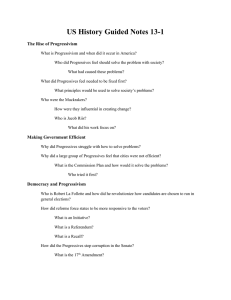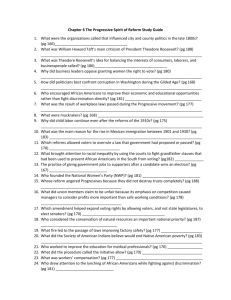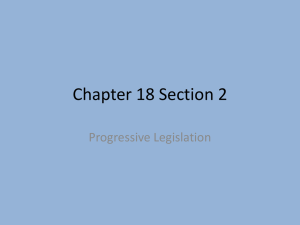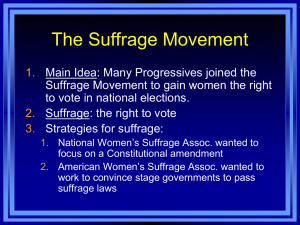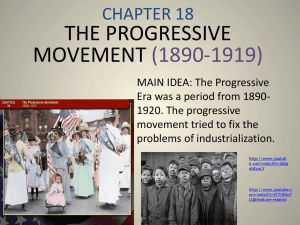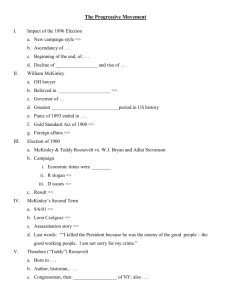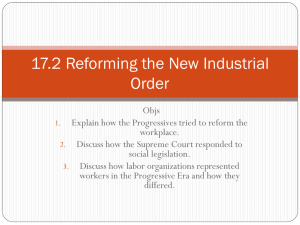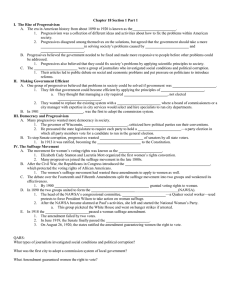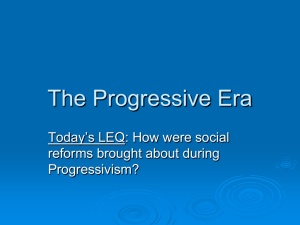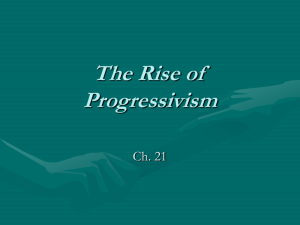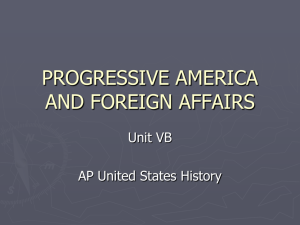U.S. History: Progressive Reform Era Test - Chapter 18
advertisement
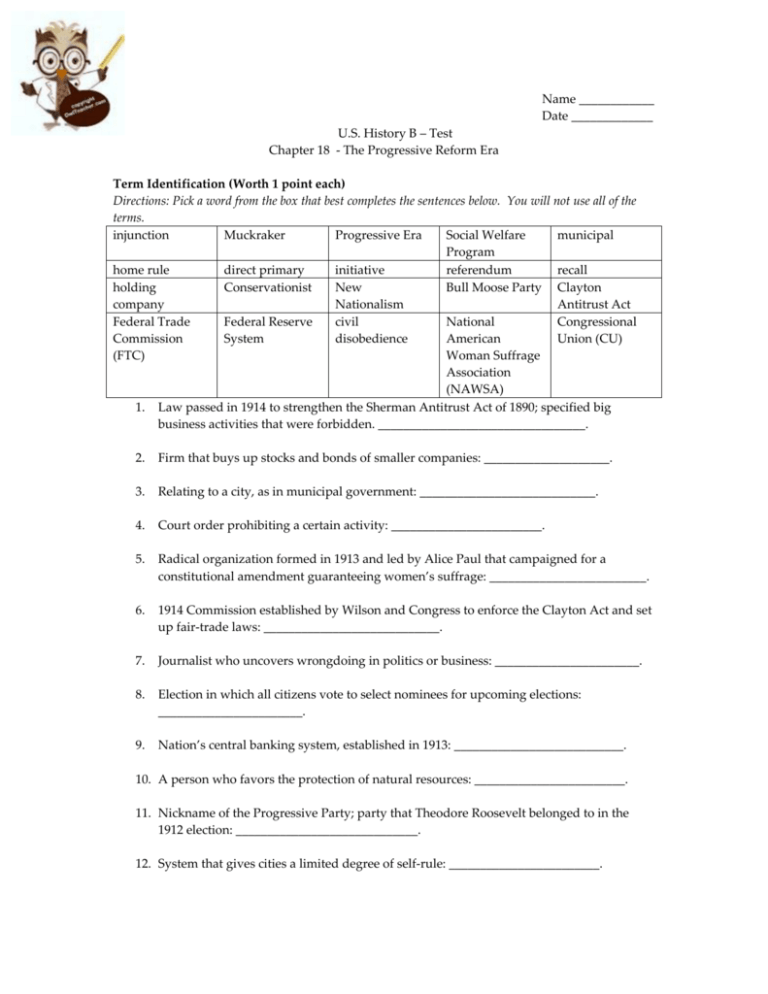
Name ____________ Date _____________ U.S. History B – Test Chapter 18 - The Progressive Reform Era Term Identification (Worth 1 point each) Directions: Pick a word from the box that best completes the sentences below. You will not use all of the terms. injunction Muckraker Progressive Era Social Welfare municipal Program home rule direct primary initiative referendum recall holding Conservationist New Bull Moose Party Clayton company Nationalism Antitrust Act Congressional Federal Reserve civil National Federal Trade Union (CU) System disobedience American Commission Woman Suffrage (FTC) Association (NAWSA) 1. Law passed in 1914 to strengthen the Sherman Antitrust Act of 1890; specified big business activities that were forbidden. _________________________________. 2. Firm that buys up stocks and bonds of smaller companies: ____________________. 3. Relating to a city, as in municipal government: ____________________________. 4. Court order prohibiting a certain activity: ________________________. 5. Radical organization formed in 1913 and led by Alice Paul that campaigned for a constitutional amendment guaranteeing women’s suffrage: _________________________. 6. 1914 Commission established by Wilson and Congress to enforce the Clayton Act and set up fair-trade laws: ____________________________. 7. Journalist who uncovers wrongdoing in politics or business: _______________________. 8. Election in which all citizens vote to select nominees for upcoming elections: _______________________. 9. Nation’s central banking system, established in 1913: ___________________________. 10. A person who favors the protection of natural resources: ________________________. 11. Nickname of the Progressive Party; party that Theodore Roosevelt belonged to in the 1912 election: _____________________________. 12. System that gives cities a limited degree of self-rule: ________________________. 13. Procedure that permits voters to remove public officials from office before the next election: ____________________________. 14. The period from about 1890 to 1920, during which a variety of reforms were created at the local, state, and federal level: _____________________________. 15. Process that allows citizens to approve or reject a law passed by their legislature: _________________________________. Multiple Choice (Worth 4 pts. Each) 1. What are some reasons that Progressivism began? a. People were bored and needed something to do. b. Rapid industrialization, immigration, and urbanization in the late 1800s. c. People wanted to create social welfare programs. d. Rapid industrialization, immigration, and civil wars were becoming bigger problems in the United States in the late 1800s. 2. What did many Progressives believe were the right method(s) to bring about progress in society? a. Private charities. b. Arresting child labor employers and political bosses. c. All American workers going on strike throughout the country. d. Political action and reform. 3. One common basic belief of Progressives was that a. Government should stay out of citizens’ problems altogether. b. Government should be more accountable to its citizens. c. Send the military in to solve the problem. d. Some violence was necessary to bring about change. 4. Progressives sought or looked for more social welfare programs to help ensure a. More employment to welfare workers. b. All people were being helped. c. Education to immigrants. d. A minimum standard of living. 5. What did the Meat Inspection Act of 1906 do? a. Required federal inspection of cattle ranches to ensure sanitary conditions. b. Required markets to put expiration dates on meat packages. c. Required federal inspection of meat processing to ensure sanitary conditions. d. Created bars where singles could go and socialize. 6. Who did William Howard Taft anger on the issue of public land management? a. Conservationists. b. Republican politicians. c. Immigrants. d. Railroad workers. 7. Which two groups did the Women’s Suffrage movement split into? a. The Right Wing & The Left Wing. b. The National Woman Suffrage Association & The American Woman Suffrage Association. c. The NAWSA & The Congressional Union (CU). d. The Feminists & The Conservatives. 8. What did Susan B. Anthony do in 1872 that got her arrested? a. Attacked a politician who was against women’s suffrage. b. Disturbed the peace when she led a march in Washington D.C. c. Refused to pay her taxes. d. Insisted on voting in Rochester, New York. 9. What was Woodrow Wilson’s first victory as President? a. Finishing the Panama Canal. b. Tariff reduction. c. Outlawing child labor. d. Creating jobs for illiterate immigrants. 10. William Howard Taft chose ______ for Secretary of the Interior. a. Susan B. Anthony. b. Theodore Roosevelt. c. Richard A. Ballinger. d. Eugene V. Debs. Short Answers. (Worth 4 points each). Directions: Answer the following questions completely.. 11. Progressives were not a single, unified movement. What are the four categories that Progressives fell into? . 12. What were some Progressive Political Reforms? 13. Describe the election of 1912: 14. Under Theodore Roosevelt’s New Nationalism or Square Deal, what did he call for? In other words, what things did he want to improve and change in the United States? 15. Which state became the first to grant women the right to vote? In what year? Essay. (Worth 12 ½ points each). Directions: Choose TWO of the following four essay questions to write on. Answers must be at least one paragraph long to receive full credit. That means at least 5 complete sentences. You may write on the back of the pages of this test. 1. How did Henry George and Edward Bellamy influence the rise of progressivism? 2. Summarize the Progressives’ views on regulating business: 3. What effect did the Bull Moose Party have on the election of 1912? 4. How did the passage of the 19th amendment come about? Why did it take so long? (note: If you correctly answer more than two essay questions, you will receive 5 bonus points for each one.)
